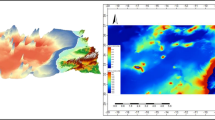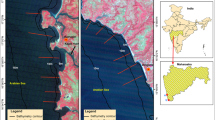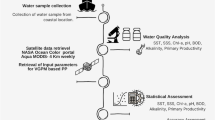Abstract
The nearshore variation in suspended sediment concentration (SSC) is essential to understand the circulation and sediment transport in and around the coastal area. SSC was derived from shoreline to 20 m bathymetric contour for thirteen transects selected between Malpe and Talapady along the southern Karnataka coast, India. Ocean colour monitor (OCM) and in-situ derived SSC was compared for validation of satellite data. High SSC in the southern side of the study area is due to high wave activity, beach erosion, sediment discharge from the river, dredging activity of New Mangalore Port, and construction of offshore reef at Ullal. In-situ samples show high SSC concentration in the bottom waters in estuaries which signify the dominance of bed load transport over suspended load. In nearshore waters, high concentration in the surface, mid and bottom waters are observed along the stations impacted by anthropogenic activities. The in-situ data is observed to be positively correlating (± 10 mg/l) with OCM data. SSC values deciphered using the modified Tassan algorithm provides accurate estimates in coastal waters off south-west India. The sediment transport pattern derived from statistical parameters of bed sediment samples showed offshore, southward and northward direction. Natural and anthropogenic structures act as a barrier to coastal sediment transport. The direction of sediment transport patterns in the coastal waters is useful for the maintenance of navigational channels and planning the coastal structures in the coastal zone.






Similar content being viewed by others
References
Aagaard, T., & Jensen, S. G. (2013). Sediment concentration and vertical mixing under breaking waves. Marine Geology, 336, 146–159. https://doi.org/10.1016/j.margeo.2012.11.015
Acker, J., Quillon, S., Gould, R., & Arnone, R. (2005). Measuring marine suspended sediment concentration from space: History and potential. International Conference on Remote Sensing for Marine and Coastal Environments, Halifax, Canada. 10p.
Amoudry, L. O., & Souza, A. J. (2011). Deterministic coastal morphological and sediment transport modeling: A review and discussion. Rev Geophys, 49. https://doi.org/10.1029/2010RG000341
Anilkumar, N., Sarma, Y. V. B., & Babu, K. N. (2006). Post-tsunami oceanographic conditions in southern Arabian Sea and Bay of Bengal. Current Science, 90(3), 10p.
Avinash, K., Jayappa, K. S., & Vethamony, P. (2011). Evolution of Swarna estuary and its impact on braided islands and estuarine banks, Southwest coast of India. Environment and Earth Science, 65(3), 835–848.
Avinash, K., Jena, B., Vinaya, M., Jayappa, K. S., Narayana, A. C., & Bhat, H. G. (2012). Regionally tuned algorithm to study the seasonal variation of suspended sediment concentration using IRS-P4 Ocean Colour Monitor data. Egypt J Remote Sens Space Sci, 15(1), 67–81. https://doi.org/10.1016/j.ejrs.2012.05.003
Bergillos, R. J., López-Ruiz, A., Ortega-Sánchez, M., Masselink, G., & Losada, M. A. (2016). Implications of delta retreat on wave propagation and longshore sediment transport-Guadalfeo case study (southern Spain). Marine Geology, 382, 1–16.
Chauhan, O. S., Rajawat, A. S., Pradhan, Y., Suneethi, J., & Nayak, S. R. (2005). Weekly observations on dispersal and sink pathways of the terrigenous flux of the Ganga– Brahmaputra in the Bay of Bengal during NE monsoon. Deep Sea Res, 2(52), 2018–2030.
Costa, P. J. M. (2016). Sediment Transport. In: Kennish M.J. (eds) Encyclopedia of Estuaries. Encyclopedia of Earth Sciences Series, Springer, Dordrecht. https://doi.org/10.1007/978-94-017-8801-4.
CWC (2017). Integrated Hydrological Data Book. Hydrological Data Directorate, Central Water Commission, Government of India. http://cwc.gov.in/publications?title=integrated+hydr. Accessed 07 October 2019.
Deepika, B., & Jayappa, K. S. (2017). Seasonal beach morphological changes along the coast of Udupi district, west coast of India. Journal of Coastal Conservation, 21(4), 545–559. https://doi.org/10.1007/s11852-017-0529-1
Doerffer, R. (1992). Imaging spectroscopy for detection of chlorophyll and suspended matter. Toselli F and Bodechtel J (Eds) London: Kluwer Academic Publishers. pp.215–257.
Dyer, K. R. (1989). Sediment processes in estuaries: Future research requirements. Journal of Geophysical Research, 94, 14327–14339.
Erftemeijer, P. L., Riegl, B., Hoeksema, B. W., & Todd, P. A. (2012). Environmental impacts of dredging and other sediment disturbances on corals: a review. Mar Poll Bul, 64(9), 1737–1765. https://doi.org/10.1016/j.marpolbul.2012.05.008
Erico, J. D., Miller, R. L., & Brent, A. M. (2007). Suspended particulate matter in coastal waters from ocean color: application to the northern Gulf of Mexico. Journal of Geophysical Research, 34, 1–6.
Fu, W., Ma, J., Chen, P., & Chen, F. (2019). Remote Sensing Satellites for Digital Earth. Manual of Digital Earth, 55–123. https://doi.org/10.1007/978-981-32-9915-3-
Gao, S., & Collins, M. (1992). Net sediment transport patterns inferred from grain-size trends based upon definition of “transport vectors.” Sedimentary Geology, 81(1–2), 47–60. https://doi.org/10.1016/0037-0738(92)90055-v
Garaba, S., VoB, D., & Zielinski, O. (2014). Physical, bio-optical state and correlations in North-Western European shelf seas. Rem Sens, 6(6), 5042–5066. https://doi.org/10.3390/rs6065042
Giardino, A., Schrijvershof, R., Nederhoff, C. M., de Vroeg, H., Brière, C., Tonnon, P.-K., Caires, S., Walstra, D. J., Sosa, J., van Verseveld, W., Schellekens, J., & Sloff, C. J. (2018). A quantitative assessment of human interventions and climate change on the West African sediment budget. Ocean and Coastal Management, 156, 249–265. https://doi.org/10.1016/j.ocecoaman.2017.11.008
Gordon, H. R. (1997). Atmospheric correction of ocean color imagery in the earth observing system era. Journal of Geophysical Research, 102, 17081–17106.
Holt, J. T., & James, I. D. (1999). A simulation of the southern North Sea in comparison with measurements from the North Sea project part 2 suspended particulate matter. Continental Shelf Research, 19, 1617–1642.
Jayappa, K. S., Vijaya Kumar, G. T., & Subrahmanya, K. R. (2003) Influence of coastal structures on the beaches of southern Karnataka, India. J Coast Res, 19(2), 389–408. https://www.jstor.org/stable/4299180.
Kairyte, M., & Stevens, R. L. (2015). Composite methodology for interpreting sediment transport pathways from spatial trends in grain size: a case study of the Lithuanian coast. Sedimentology, 62, 681–696. https://doi.org/10.1111/sed.12156
Kim, S., Yang, D. S. & Kim, Y. S. (2020). Distribution of metal contamination and grain size in the sediments of Nakdong River, Korea. Environ Monit Assess. https://doi.org/10.1007/s10661-020-08475-z.
Kunte, P. D. (2008). Sediment concentration and bed form structures of Gulf of Cambay from remote sensing. International Journal of Remote Sensing, 29(8), 2169–2182.
Leys, V., & Mulligan P., R. (2011). Modelling Coastal Sediment Transport for Harbour Planning: Selected Case Studies. Sediment Transport. https://doi.org/10.5772/1500
Liu, J. H., Yang, S. L., Zhu, Q., & Zhang, J. (2014). Controls on suspended sediment concentration profiles in the shallow and turbid Yangtze Estuary. Continental Shelf Research, 90, 96–108. https://doi.org/10.1016/j.csr.2014.01.021i
Liu, W. C., Hsu, M. H., & Kuo, A. Y. (2002). Modelling of hydrodynamics and cohesive sediment transport in Tanshui river estuarine system, Taiwan. Marine Pollution Bulletin, 44(10), 1076–1088.
Lumborg, U. (2004). Modelling the deposition, erosion and flux of cohesive sediment through Øresund. J Marine Syst, 56(1–2), 179–193.
Mclaren, P. (1981). An interpretation of trends in grain size measures. Journal of Sedimentary Research, 51(2), 611–624. https://doi.org/10.1306/212f7cf2-2b24-11d7-8648000102c1865d
Miller, R. L., & McKee, B. A. (2004). Using MODIS Terra 250m imagery to map concentrations suspended matter in coastal waters. Remote Sensing of Environment, 93(1–2), 259–266.
Miranda, L. S., Wijesiri, B., Ayoko, G. A., Egodawatta, P., & Goonetilleke, A. (2021). Water-sediment interactions and mobility of heavy metals in aquatic environments. Water Research, 202. https://doi.org/10.1016/j.watres.2021.117386
Moreira, D., & Simionato, C. G. (2019). Modeling the suspended sediment transport in a very wide, shallow, and microtidal estuary, the Río de la Plata. Argentina J Adv Mod Earth Syst, 11(10), 3284–3304.
Morris, A. W., & Howarth, M. J. (1998). Bed stress induced sediment resuspension. Continental Shelf Research, 18(11), 1203–1213.
Murphy, S., & Voulgaris, G. (2006). Identifying the role of tides, rainfall and seasonality in marsh sedimentation using long-term suspended sediment concentration data. Marine Geology, 227, 31–50.
Murthy, M. V., Ravichandran, V., Vendhan, M., Kiran, A. S., Raju, S. K., Avula, A. K, Varthini, S., Abhishek, T. (2020). Shore Protection Measures along Indian Coast – Design to Implementation Based on Two Case Studies. Cur Sci, 118(11). https://doi.org/10.18520/cs/v118/i11/1768-1773.
Nayak, S. (2017). Coastal zone management in India—present status and future needs. Coastal zone management in India—present status and future needs. Geo-spatial Info Sci, 20:2, 174–183. https://doi.org/10.1080/10095020.2017.1333715.
New Mangalore Port Trust (2018). Administration Report: 2017–2018. Government of India, Ministry of Shipping. http://newmangaloreport.gov.in:8080/#!/adm_report. Accessed 15 December 2019.
NHO (2005). Bathymetric chart no. 217 from Kundapura to Kasaragod, India; National Hydrographic Office of India, Superintendence by Rear Admiral B. R. Rao.
Nowacki, D., & Ganju, N. (2018). Storm impacts on hydrodynamics and suspended-sediment fluxes in a microtidal back-barrier estuary. Marine Geology, 404, 1–14. https://doi.org/10.1016/j.margeo.2018.06.016
Onishi, Y., Serne, J., Arnold, E., Cowan, C., & Thompson, F. (1981). Critical review: radionuclide transport, sediment transport, water quality, mathematical modelling and radionuclide adsorption/desorption mechanism. Pacific Northwest Laboratory, Richland. pp.512.
Pradhan, Y., Thomaskutty, A. V., Rajawat, A. S., & Nayak, S. (2005). Improved regional algorithm to retrieve suspended particulate matter using IRS-P4 ocean colour monitor data. Journal of Optics a: Pure and Applied Optics, 7, 343–349.
Prasad, J. S., Rajawat, A. S., Pradhan, Y., Chauhan, O. S., & Nayak, S. R. (2002). Retrieval of sea surface velocities using sequential Ocean Colour Monitor (OCM) data. J Earth Sys Sci, 111(3), 189–195. https://doi.org/10.1007/bf02701965
Putro, A. H. S., & Lee, J. L. (2020). Analysis of longshore drift patterns on the littoral system of Nusa Dua beach in Bali Indonesia. J Mar Sci Eng, 8, 749. https://doi.org/10.3390/jmse8100749
Quantum GIS Development Team (2012) Quantum GIS Geographic Information System. Open Source Geospatial Foundation. http://qgis.osgeo.org
Rajput, P., Ramakrishnan, R., & Rajawat, A. S. (2014). Retrieval of coastal ocean currents using MCC technique on satellite imagery for supplementing altimeter derived currents. The Int Arch Photogrammetry, Remote Sens Spatial Inf Sci, XL-8, 1483–1489. https://doi.org/10.5194/isprsarchives-xl-8-1483-2014.
Ramakrishnan, D., Rishikesh, B., & Das, M. (2013). A technique for estimation of suspended sediment concentration in very high turbid coastal waters: an investigation from Gulf of Cambay, India. Marine Geology, 346, 256–261. https://doi.org/10.1016/j.margeo.2013.10.001
Rangel-Buitrago N., Neal W. J. (2018) Coastal Erosion Management. In: Finkl C.W., Makowski C. (eds) Encyclopedia of Coastal Science. Encyclopedia of Earth Sciences Series. Springer. https://doi.org/10.1007/978-3-319-48657-4.
Ratheesh, R., & Rajawat, A. S. (2012). Simulation of suspended sediment transport initialized with satellite derived suspended sediment concentrations. Journal of Earth System Science, 121(5), 1201–1213.
Rosati, J. D. (2005). Concepts in sediment budgets. Journal of Coastal Research, 21(2), 307–322. https://doi.org/10.2112/02-475A.1
Sathasivam, S., Rasheed, K., Kankara, R. S., Muthusamy, M., Samykannu, A., & Boopati, R. (2015). SSC analysis of south maharashtra coast: a case study from vengurla coastal region. Aquatic Procedia, 4, 19–24. https://doi.org/10.1016/j.aqpro.2015.02.004
Shen, F., Verhoef, W., Zhou, Y., Salama, M. S., & Liu, X. (2010). Satellite estimates of wide-range suspended sediment concentrations in Changjiang (Yangtze) Estuary using MERIS data. Estuaries and Coasts, 33(6), 1420–1429.
Shetty, A., & Jayappa, K. S. (2020). Seasonal variation in longshore sediment transport rate and its impact on sediment budget along the wave-dominated Karnataka coast, India. Journal of Earth System Science, 129, 1–14. https://doi.org/10.1007/s12040-020-01504-y
Shetty, A., Jayappa, K. S., Ramakrishnan, R., & Rajawat, A. S. (2019). Shoreline dynamics and vulnerability assessment along the Karnataka coast, India: a geo-statistical approach. J Indian Soc Remote Sens, 47, 1223–1234. https://doi.org/10.1007/s12524-019-00980-0
Shrestha P. L., & Blumberg A. F. (2005). Cohesive Sediment Transport. In: Schwartz M.L. (eds) Encyclopedia of Coastal Science. Encyclopedia of Earth Science Series, Springer. https://doi.org/10.1007/1-4020-3880-1
SoI (2015) Tidal Predication. Survey of India, Dept of Science & Tech. http://www.surveyofindia.gov.in.
Soulsby, R. (1997). Dynamics of marine sands. A manual for practical applications. Thomas Telford services limited. pp.249.
Sravanthi, N., Ramakrishnan, R., Rajawat, A. S., & Narayana, A. C. (2015). Application of numerical model in suspended sediment transport studies along the Central Kerala, West-coast of India. Aquatic Procedia, 4, 109–116. https://doi.org/10.1016/j.aqpro.2015.02.016
Strickland, J. D. H., & Parsons, T. R. (1972). A practical handbook of sea-water analysis. J Fish Res Bd Canada, 2, 311.
Subrahmanya, K. R. (1998). Tectono-magnetic evolution of west coast of India. Gondwana Research, 314, 319–327.
Tassan, S. (1994). Local algorithm using SeaWiFS data for retrieval of phytoplankton pigment, suspended sediments and yellow substance in coastal waters. Applied Optics, 33(12), 2369–2378.
Walton, T. L., & Dean, R. G. (2010). Longshore sediment transport via littoral drift rose. Ocean Engineering, 37, 228–235.
Whitehouse, R., Soulsby, R., William, R., & Mitchener, H. (2000). Dynamics of estuarine muds: a manual for practical applications. Thomas Telford.
Zheng, G., & Tang, D. L. (2007). Offshore and nearshore chlorophyll increases induced by typhoon and typhoon rain. Marine Ecology Progress Series, 333, 61–74.
Zonta, R., Collavini, F., Zaggia, L., & Zuliani, A. (2005). The effect of floods on the transport of suspended sediments and contaminants: a case study from the estuary of the Dese River (Venice Lagoon, Italy). Environment International, 31(7), 948–958.
Acknowledgements
The authors are thankful to the Space Applications Centre, ISRO, Ahmedabad for the award of Research Project under the Meteorology and Oceanography Programme—III (SAC/EPSA/MPSG/GSD/MOP3/CST/WP/01/2013, dated 16.08.2013). The authors thank the Department of Marine Geology, Mangalore University for extending facilities and the College of Fisheries, Mangaluru is acknowledged for providing the research vessel for the collection of water and sediment samples. The authors thank the anonymous reviewers and the editor for their constructive comments and scientific suggestions to improve the original manuscript.
Author information
Authors and Affiliations
Corresponding author
Ethics declarations
Conflict of interest
No conflicts of interest to disclose.
Additional information
Communicated by M. V. Alves Martins
Publisher's Note
Springer Nature remains neutral with regard to jurisdictional claims in published maps and institutional affiliations.
Rights and permissions
About this article
Cite this article
Shetty, A., Jayappa, K.S., Deepak, P.R. et al. Nearshore suspended sediment concentration and transport pattern along the southern Karnataka coast, India. J. Sediment. Environ. 7, 95–110 (2022). https://doi.org/10.1007/s43217-021-00086-z
Received:
Revised:
Accepted:
Published:
Issue Date:
DOI: https://doi.org/10.1007/s43217-021-00086-z




